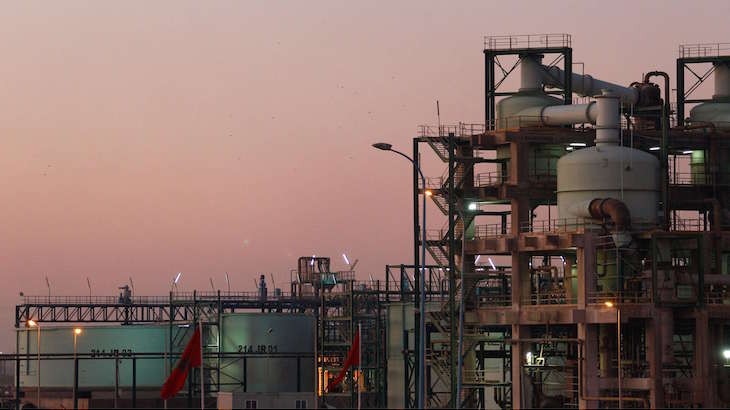Just as the gold rush built Johannesburg, Morocco’s town of Khouribga was built to service the monumental phosphate deposit discovered in Boujniba in 1917 – some 31% of global reserves. Since then its destiny has been inextricably linked to that of the Office Chérifien des Phosphates – now the OCP Group.
Leaving Khouribga to the south, looking towards Boujniba, you can’t miss the huge mounds left by the extraction of millions of tonnes of phosphate rock. “There used to be many more,” says Brahim Ramdani, OCP’s director of mines in Khourigba. For several years now, the company has been flattening these mini-mountains and using them to plant millions of trees. It is just one of the thousands of projects in the $8bn investment programme OCP launched in 2008, which in 10 years has transformed the company and, with it, Khouribga. OCP is now Morocco’s largest group, with a 2017 turnover of €4.3bn.
The plan, financed by sky-high prices for phosphate, was to double phosphate mining activity and triple fertiliser production by 2020. It was a two-pronged strategy, suggests one Middle Eastern importer who requested anonymity: “Partly to become flexible enough to export more of one product – be it phosphate rock, phosphoric acid or fertiliser – to meet market demand at any particular moment. […] But also to dissuade other rival producers from trying to enter the race.”
Back in the early years of the century, OCP’s margins were small, and the company was caught up in the machinery of state, run by officials linked to the royal palace. Under Mostafa Terrab, it became a limited company in 2008 and restructured its management and operations: from logistics to sales. Over the next decade, OCP went from 28m tonnes of phosphates mined to 45m, and fertiliser output leapt from 3.6m tonnes to nearly 12m tonnes per annum. It now has a gross operating surplus of more than $1bn.
There have been other innovations. Where the rock was previously hauled by train 150km from the Khouribga mines to the port of Jorf Lasfar, it is now pumped through a metre-wide, steel and rubber slurry pipe. Sensors at each mine and along the pipeline allow a new data-management system to track volumes and identify problems as they develop. A plan to replicate the system for the mines of Ben Guerir is taking shape.
Industry is greedy for energy
At the other end of the pipe, the port of Jorf Lasfar is transforming into the largest fertiliser production hub in the world, with a capacity to produce 11m tonnes of phosphate fertiliser per year and 6m tonnes of phosphoric acid. The whiff of sulphur wafts over the complex. Some 45 different blends of fertiliser are created there, ready to be shipped out from Jorf Lasfar, which last year overtook the port of Casablanca in tonnage exported.
All this requires energy. OCP alone consumes 6%-7% of Morocco’s annual energy supply and 1% of its water. “As soon as we boost production, we have to systematically think of ways to lower costs,” says Amine Kaf, the Jorf Lasfar facility director. “We need both flexibility and sustainable development. We have brought in the best industrial consultants, like Jacobs Engineering and DuPont, to help us square that circle.”
Given the immense technical challenges, OCP is investing in research and training engineers. It built Université Mohammed VI Polytechnique at Ben Guerir, with its well-equiped laboratories to do research in agronomy, nanotechnology and soil analysis. Its current few hundred students should number 5,000 at maturity. The school has forged partnerships with the US-based Massachusetts Institute of Technology (MIT), France’s Ecole de Mines de Paris and Canada’s Université Laval.
Open innovation
OCP chief economist, Mohamed Soual, adds: “The university allows us access to many research institutions around the world and allows us to participate in ‘open innovation’ […]. We can’t keep chasing academics around the world and offering them consulting contracts.” The group has even created a think tank, the OCP Policy Center, to tackle the political angles of global business.
Step inside OCP’s headquarters in Casablanca, and you might think yourself in Silicon Valley. Even more so on the first floor, dubbed the ‘Digital Factory’. A young woman wearing a hijab plays ping pong during lunch, and there are many whiteboards and Post-it notes. This US-inspired environment is not without business logic. Trade with the United States represents between 25% and 30% of the group’s turnover.
OCP’s ambitions are to take this as the first phase of a much larger journey. “We cannot be satisfied with being 17%-18% of global phosphate production when we have 72% of global phosphate reserves,” says Soual, taking aim at competitors like Russia’s PhosAgro and Saudi Arabia’s Ma’aden. “And we also need to diversify, hence our purchase of a Spanish biostimulant company and a new partnership with a Chinese group who are specialists in fertiliser additives.”
But all is not plain sailing for OCP, which has faced hard times in the past (see box). There remains, for example, the domestic political context of the group, operating in the sensitive Western Sahara region. The Polisario Front, which does not recognise Morocco’s sovereignty in the region, regularly tries to intercept OCP cargoes around the world. The OCP-backed Phosboucraa Foundation is trying to improve relations by investing in the city of Laayoune and elsewhere in the region.
And then there is the question of OCP’s debt. To execute its expansion plans covering the period until 2027, OCP will need to invest more than $9bn. In May, it raised Dh5bn ($526m) on the local market, following fundraising of $2.6bn on the international markets in 2014 and 2015. Today, total debt is estimated at Dh45bn – about three times OCP’s earnings before interest, tax, depreciation and amortisation. The company lost Dh1.6bn in the last financial year.

